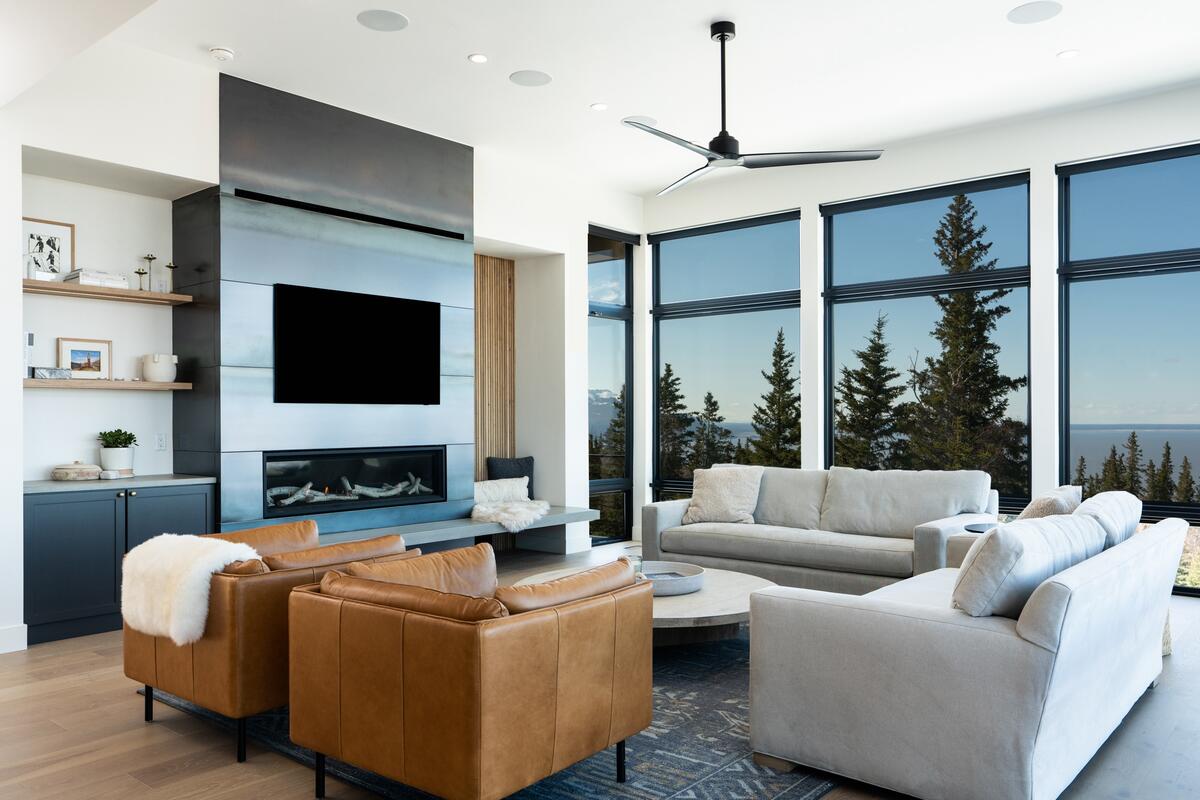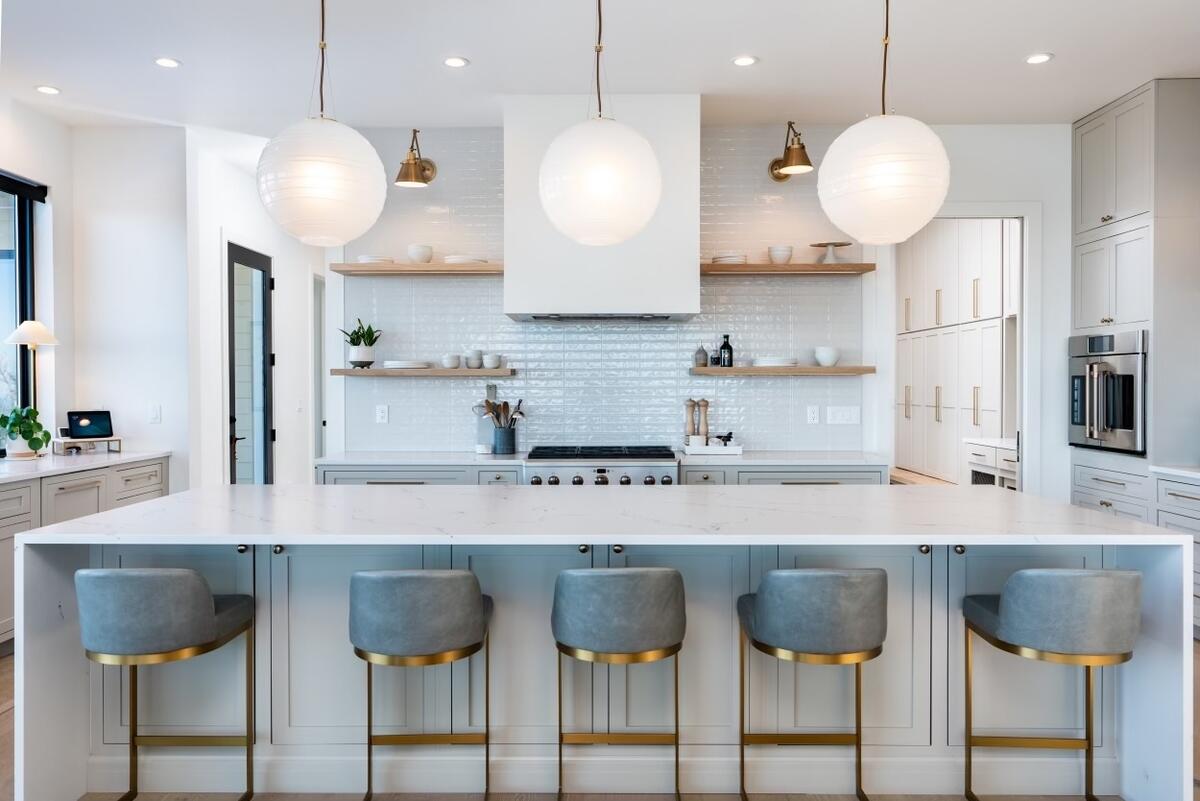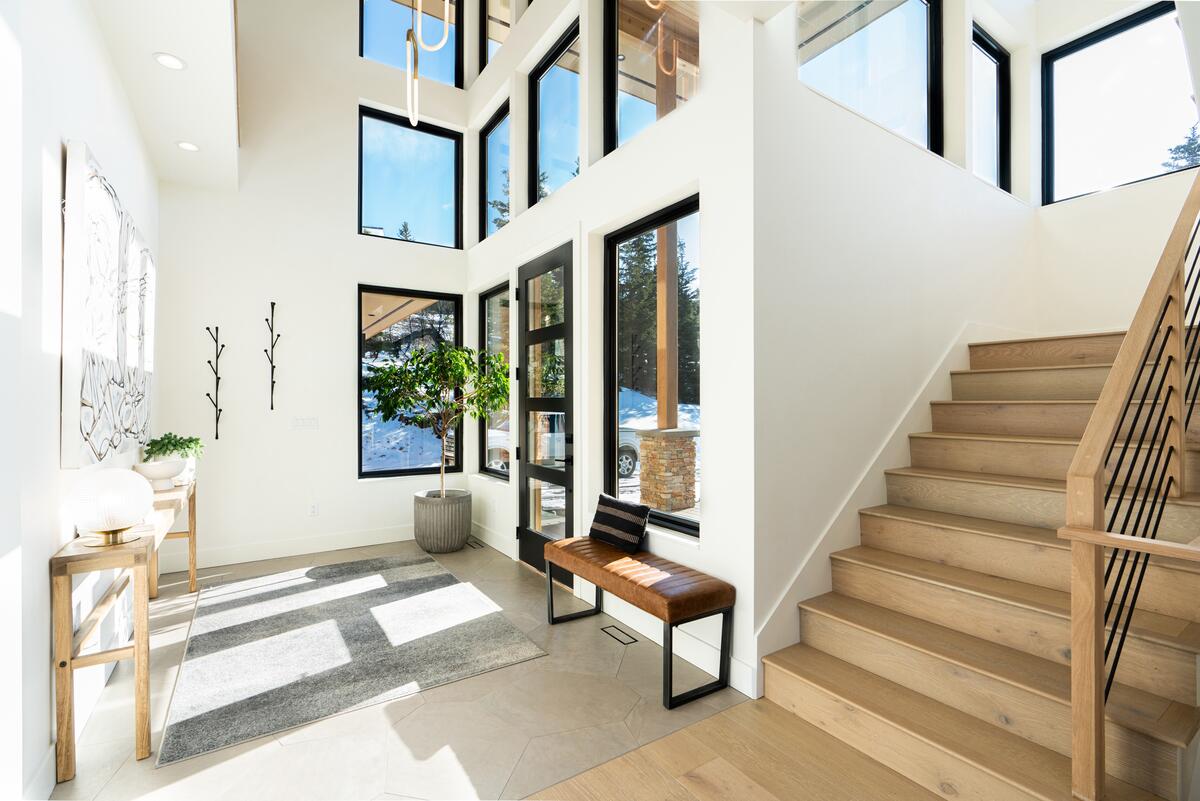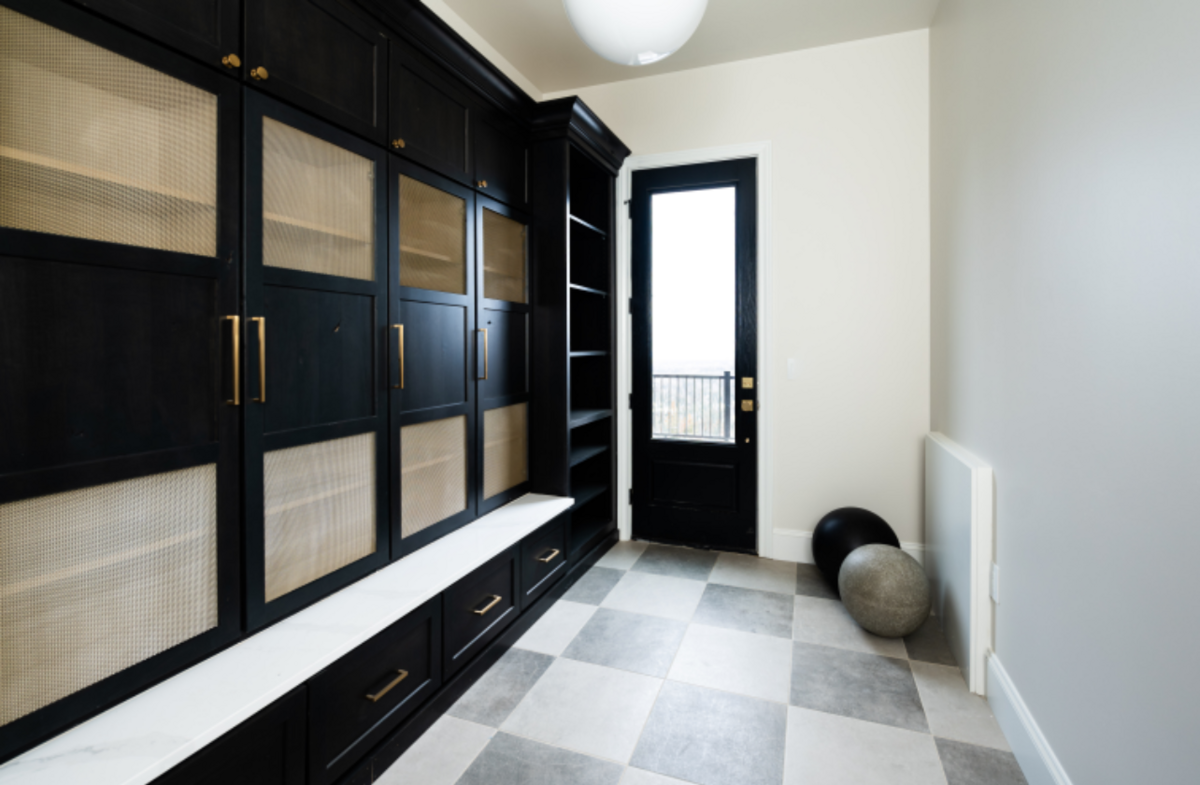The 50 States Project is a series of candid conversations with interior designers across the country about how they’ve built their businesses. This week, Anchorage-area designers Monique Jackson and Bobbi Schaar of Arctic Birch Interiors tell us why they’re never driven by money, how their partnership fuels them, and how they tackle the logistical hurdles of sourcing in a far-flung locale.
How did the two of you meet and decide to found your firm?
Bobbi Schaar: When I moved up from Texas in the summer of 2022, I found Monique on Instagram, and we met for lunch. At that time, she brought me into the design studio she was working at—long story short, we ended up leaving and starting our own company instead of working for somebody else. It definitely took off faster than we had anticipated. All of it was within—what, two months?
Monique Jackson: That sounds right. I had actually gone to school for culinary arts, and during that time, I always was curious about what the design kids were doing. I loved shelter magazines and I sucked up any information about interior design that I could, but I didn’t see it as a path for me, because I was from small-town Alaska and didn’t know anybody who had done that, so I thought something artistic and hands-on, like cooking, would be more my jam.
I had always wanted to build a house from scratch, and I finally had the opportunity to do it a few years ago. When I did that, I started a little Instagram page, which got a lot of local people following it. More and more people started reaching out to me to help them with their own builds, and I kept saying, “No, I’m sorry, I’m not an interior designer.” Then a friend of a friend had a relative who owned a design [firm], and they were like, “We want you to come help people pick out finishes—that’s all you have to do,” and I was like, “Oh, I can do that. That sounds super easy.” I was about to exit [that role] when I met Bobbi, and I wanted her to take over for me. I was like, “You can just take over my job,” and she’s like, “No, let’s just do this together.”
Were you going to exit to do other things in design?
Jackson: I was getting burnt out, honestly. The role had very defined parameters, and I was wanting to really go for it and do something bigger.
Monique, you grew up in Alaska; Bobbi, you didn’t. I’m curious how each of you experienced the design industry, or what you thought this business could be, before you were actually in it?
Schaar: It’s different being from the Lower 48. I actually went to college for dental hygiene. My husband is active military, so we move a lot, but I have always been the person that all the family members would go to asking, “Hey, what paint color?” Neighbors always wanted me to help with their house. I built a builder-grade house while I was in Texas, and then I had a friend who built a house, and I pretty much designed that with her. Then I built our house up in Alaska from Texas—we hadn’t moved yet—which was crazy. I always thought of interior design as a dream job, something I would do even if I didn’t get paid.
I got offered a job at a dental office, like, two days after I moved up here, but I reached out to Monique because I was interested in her work. [Just a couple years in], I feel like I could go design in the Lower 48 and it would be so easy, because [the challenges of] designing up here are a lot different. Everyone [not familiar with Alaska] thinks it’s all log cabins and outhouses, but there are gorgeous homes up here—it’s just way more expensive than building in the Lower 48.
Jackson: And logistically challenging.
Schaar: Getting supplies up here and everything. But from a design standpoint, there are some [homes that] would fit into Montana or Utah or Colorado. We’re very mountain-modern-ish. There was a hole in that design area up here that we’re kind of filling.
What was the prevailing aesthetic? Why was there a blank space in the market?
Jackson: People get in a rut because they go to the same three places for their sources. They don’t have the resources to go one step beyond that.
Schaar: They can’t go to Crate & Barrel and look. It’s like, “Well, what does Costco have today?” The big furniture stores that we do have are marked up like five times what it should be.
Jackson: [Social media is] making people more exposed to design as well, so then they see it and want it, but they just don’t know how to execute it with what’s available to them. That’s where we came in.

When the two of you met, what was the synergy that made you feel confident going into business with each other so quickly?
Jackson: I think it was a God thing, for sure.
Schaar: When you meet somebody and you know they have the same integrity, or the same foundation as you, you can build upon that. I trust her fully; she trusts me fully. We just work really well together, which is uncommon to find. And we know that it’s not normal to be able to work with someone so well, especially [starting out] not knowing each other. I think it was definitely God. Once we saw that and how fast it took off, we just kind of went with it.
Jackson: Now life is taking us in different directions. Bobbi is leaving Alaska next summer, and I have a new grandbaby. If she wasn’t leaving, I think we probably would have been like, “OK, now we really need to figure out the business part of it”—sign up for those Business of Home workshops and get into the nitty-gritty.
Schaar: I move to Michigan on July 26, and we have projects leading us all the way up to then. So we’re not taking [new] clients at this time. But we’re open. We’re not like, “OK, this is the end.”
You said that business took off faster than you expected. What did that look like in practice?
Schaar: We started with one project, just furniture, and those people probably recommended us to—what, 10 more people? And then those people would recommend us, and so on. Along the way, we found that we really loved working on the high-end new builds, so we dialed in on that. But it took off like crazy, and we didn’t know when to say no. At the beginning, we were honestly just like, “Oh, my gosh, we’ll take it!” For a year, I felt like I was working nonstop. I’d get up and work before the kids [got up], and work until I went to sleep at night. But we didn’t expect that [when] starting a business.
Jackson: We just had an Instagram account and posted there. They’d seen my house on Instagram—my little account had some traction already, and then I was like, “OK, now I’m doing interior design.”
Schaar: Our first client meetings were at your house. And then once we finished our first house and got photos of it, people saw [what we can do].
Jackson: There aren’t a lot of residential interior designers in Anchorage, so that is also where we helped fill a need.
From an aesthetic perspective, where did you go above and beyond in your sourcing?
Schaar: We both got into this career field because we love it, not for the money. People saw that we were doing it truly out of love for design, and I think that makes a huge difference. When you’re working with high-end clients, they have different expectations, and they see that we go above and beyond for everything—I mean, we even went to Seattle just to look at countertops for a client, and she really appreciated it.
Jackson: And we’ve developed really good relationships with our reps, as well as all of our vendors. We have a great relationship with a countertop guy, so we can tell him, “We really want you to get this countertop,” and he’ll [do it] even though he hems and haws a little bit and says, “Why do you pick out things that I can’t get for a year and a half?” But that is the norm here in Alaska, and we make it work. When people see that, they realize that what we’re doing is different than any house they’ve ever done.

What are the logistical hurdles that you face that are different in Alaska?
Jackson: We have to freight-forward everything.
Schaar: Logistically, it’s a nightmare. For furniture, for example, we have to call the company, get everything shipped to Seattle, and then our clients have to pay for shipping from there to the port [in Alaska]. Then they have to pay another fee for freight from the port to their house. So they’re paying shipping three times for products on three different carriers. At each stage, we have to get a quote for freight, which goes back to the client, so there’s a lot of back-and-forth—[and each time] we have to make sure things aren’t damaged.
I just had a client who got the bill, and they were like, “Can we pick it up at the port to make it cheaper?” Just from the port to their house was more expensive than the freight shipping. And if something comes damaged, I mean, no one [from the company] wants to resend anything or [support us in troubleshooting all that].
Jackson: Always the mirrors.
Schaar: We’ve had product come damaged, and they wouldn’t fix it. They just gave us part of the money back. Lighting, if that’s broken, [you often can’t fix either]. They’re like, “Well, you ordered that three months ago,” but we only have a month [to make a claim]. And so we have to explain, like, “We’re in Alaska.” It’s just a whole process that [designers don’t have to deal with] in the Lower 48, where you can just order something and get it shipped to you.
Jackson: Or where you have receiving warehouses. We don’t have a place where items can sit in storage. So when people are building their house, we have to order the furniture in advance—
Schaar: And then they have to pay a fee to keep it at the port, which is insane. Or if they get a storage unit, they’re still paying, and now they’re paying shipping four times plus the storage unit. That’s also a lot of opportunities for things to get broken, and then you don’t know where or when it was broken [or who’s responsible]. We’ve definitely just [eaten] the cost of things just to make our clients happy as far as reordering goes.
From a timeline perspective, are you having to order stuff a lot earlier?
Schaar: We ordered a couch back in April, and we still do not have it. But we’ve also had some stuff that will come too early via FedEx, which is when you start worrying about storage. There’s no way to get it all lined up.
Jackson: Not accurately.
When you are talking to clients about money, how much are you telling them to expect? What percentage are they spending on freight?
Schaar: Probably 20 percent. Maybe a little bit more.
Is that something that people know to expect, or is that an unpleasant surprise?
Schaar: It’s an unpleasant surprise—
Jackson: That’s if they’re not from Alaska. I mean, if they’re from here, they’re like, “It can get to me? Awesome!”
Schaar: [When] we’re dealing with clients out of the Lower 48, [they have completely different expectations]. One of their shipping quotes, I’ll just give an example, was around $500, and they were beside themselves. If they were from Alaska, they would be like, “Oh, wow, that’s cheaper than I thought.”
Jackson: It’s about managing expectations.
Schaar: Yes. And we don’t know the cost until the freight [company] gives us the cost at the end. I’ve done it to the point where I’m like, OK, this will probably cost 20 percent, depending if they want it delivered to their garage or at the end of their driveway.

Who is your typical or ideal client? Where have you carved out a niche?
Schaar: Our minimum new build is a million dollars. We haven’t done one for [below] that. Some of them have been from [Alaska and some haven’t].
Jackson: It’s all over the place, really. Some are retired, some are just beginning their careers. Some have families, but we’re also working on a really fun project now for a single lady—we’ve had the whole gamut of people.
Schaar: There are a few ex-military people who were stationed here and stayed. Clientele [varies] from physicians to business owners to oil and gas up here.
When did you implement that budget minimum?
Schaar: It was just that from the get-go.
Jackson: I think that’s because building a custom house here is not going to be less than that. You can’t. And land is surprisingly expensive here, because in Anchorage, we’re in a bowl—there are mountains and then the water. People are always surprised that land in Alaska is expensive, but it is.
What has this very clear end date for the business changed about the way you think about what comes next?
Schaar: I think the biggest thing is we’re not taking any new clients, and for a while we were getting inquiries every day, so that’s when we decided not to post anymore to social media, really, because we didn’t want to have more inquiries.
Do you each see yourselves continuing in design after, or is this a hard stop?
Schaar: Monique might keep it up. I don’t know.
Jackson: I want to take a big break, a sabbatical.
Schaar: I could work from anywhere. I will probably build a custom home in Michigan, so there’s going to be that. We never had a business plan.
Jackson: Unfortunately. We should’ve done one.
Schaar: I think not having a business plan has kind of been a blessing in some ways, because we aren’t letting ourselves down. You know what I mean? We’re not like, “Oh, we failed at this.” This is OK. We’ll see what happens, and it’s worked so far. And I mean, I have a lot of faith in God that whatever is supposed to happen will happen with everything.
When you look ahead, do either of you have any interest in running a firm on your own, or is the partnership really what made that possible?
Schaar: I personally would not run it on my own.
Jackson: I can’t imagine that, unless you hired a bunch of people right off the bat.
Schaar: I think I would lie in bed at night and question all my decisions. I would say the hardest part for me with a business partner is always worrying that I let her down, but [I love] having another opinion on everything.
Jackson: It worked well for us.

How did you approach billing for the firm’s work?
Jackson: Well, at first, we way undercharged.
Schaar: Now we know that when dealing with a certain clientele, if you charge too little, they question your work. I mean, personally, I would try to pay someone more, knowing—
They want the best.
Schaar: Exactly. What we charge now is probably lower than in the Lower 48, but we do make a lot of our money on the furniture.
Jackson: For soft furnishings, we do a design fee, and then we make money on that.
Schaar: But most places up here mark items up 15 to 20 percent over retail, whereas we just offer retail [price] to our clients. We could mark it up more, but I just don’t feel right doing that, so we make money from our trade discount on furniture.
Jackson: And we don’t mark up shipping or anything.
Schaar: I literally screenshot the bill from freight and send it to my client so they know that’s exactly what they’re paying.
Has that always felt like the right approach?
Schaar: If we went to a business workshop, I think we would do things differently. If I were to [continue this business], I think we would definitely have to figure out how to make this more lucrative for us, because I don’t think we are—
Jackson: Maximizing that potential.
Schaar: We are not. I think we could be making a lot more money in what we’re doing, but we would need to hire someone to help us with that.
Jackson: Right now, what are we doing for hard finishes per square foot?
Schaar: We do $3 per square foot.
That’s how you’re coming up with your flat fee? How big is the average project?
Jackson: I would say 5,000 square feet.
Schaar: Our normal [flat fee] is $12,000 to $17,000 per house. I honestly think we could probably double it and people would pay it. We had a client who moved up from Arkansas and she was like, “I’ll pay you double,” just for one simple thing.
Jackson: We did have some pushback at first, though, from one of the clients who had worked with a designer before. And so then we’re like, “Oh, gosh, maybe we’re [overcharging].”
Schaar: [But] if we continue, our fee would definitely probably be double. Obviously, right now, the clients we have, we’ve already locked in their prices. We [went] to High Point this fall [to develop] more relationships with furniture vendors since we’re more profitable ordering directly from them. For now, that’s how we’re making up for any [shortage] if we don’t feel like we’re making enough.
Have you been ordering direct this whole time?
Schaar: Only from Four Hands.
Jackson: They’re really easy to work with [in] Alaska.
Schaar: Yeah, they’re great. They’ve definitely been my favorite to order from as far as [troubleshooting] any challenges, and how I can see when [the product] will actually arrive. Their dates are really accurate, and their customer service has been the best—any other company should do that.
When we’ve ordered from brands like Crate & Barrel or Pottery Barn—I don’t ever want to do that again, because if I had issues, I had to go through so many people. Whereas Four Hands, they’re quick to respond. From now on, I’m hoping that we can order directly from companies like that. I’m really hoping High Point helps with that because we’re doing some pretty large projects [in the coming months] where we’re furnishing the whole home.

What does success mean for each of you?
Jackson: For me, it is being able to have that work-life balance that everyone talks about, and also feel fulfilled in your working environment. I really enjoy being around Bobbi, learning about her family and things like that, just having a friendship as well as a workplace connection. High Point’s going to be so fun for us because we enjoy being around each other. We have the same passion for design and the same values, and we also enjoy our clients. All that’s very fulfilling, developing those relationships, even the subcontractors, and just getting to know people and having good relationships.
Schaar: For me, [success is] finding something that you love and you get paid for. Honestly, I could go do dental hygiene and make more money than I’m making now, but is it as fun? I do think having a work-life balance is really important, because last year, when we had none, I didn’t enjoy it. If that ever gets out of balance, we need to know that it’s OK to say no and be upfront with each other. Like, what the heck are we doing? And we did say that sometimes.
If the foundation of your business is integrity, and you’re putting your clients first, and you do what is right every day, the money comes. If your money is your main priority when running a business, I don’t think it’ll be as successful. Our business has grown and been successful because of our foundation. At [the end of each day], we know we did what was right for our clients. There’s never been something that I felt shady about—we are always doing what is right. And when you do that, the money comes, and it’s nice to write yourself a check.
To learn more about Arctic Birch Interiors, visit their website or find them on Instagram.




























